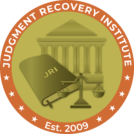OUR TRAINING METHODS - The 3 Learning Methods
Do you ever wonder why some people are known as “straight A students”?
While others who are smart, struggle in school?
Do you know someone who didn’t finish high school, and found great success in their career?
There is not one learning style that is better than another however it is important to determine what is your style. Much of our students success revolves around the fact that we recognize there are basically three predominant learning styles:
- Auditory Learners – ( those who need to hear it )
- Visual Learners – ( those who need to see it )
- Kinesthetic – Touch / Experience Learners – ( those who need to do it )

People learn in different ways! …… What’s your learning style?

Many of us learn best by using a combination of all three learning methods. The Judgment Recovery Institute has made it our commitment to ensure all three of these methods are incorporated as part of our training process, allowing you the best opportunity to learn in a method that fits your learning style. Answer the few questions below to try to determine what type of learner you are.
Question: You need to paint a room. So how much paint & what supplies do you need?
Call a painter, a friend or even a paint store. Ask for instructions before starting the project. They might even attend a course on painting at a home improvement store.
Look online for answers, read several websites. Go to a bookstore and find books or magazines about home improvement and painting. Go to the paint store and read the back of the paint cans. Watch a course at the paint store or online.
Go buy a can of paint, a brush and start painting. If there’s not enough paint or you have the wrong brushes, you just buy more. Eventually you learn how much paint and what supplies are needed to get the job done.
Question: You need to get certified in First Aid so you can become a leader of a Scout Troop. You haven’t studied First Aid since you were in high school. You decide to take a course at the local YMCA.
You find yourself at the front of the class with a pen and paper in hand, writing every word the teacher says. You might be nervous about actually doing mouth-to-mouth on the dummy but you have excellent not taking skills.
You get a book about First Aid from the library or do some online research before ever attending the class and immediately start reading the classroom handouts before the instructor even starts the class.
You walk in, see the dummies, bandages, splints and other equipment and can’t wait to try it all – the lecture might be dull and boring to you but the hands on experience is exciting.
